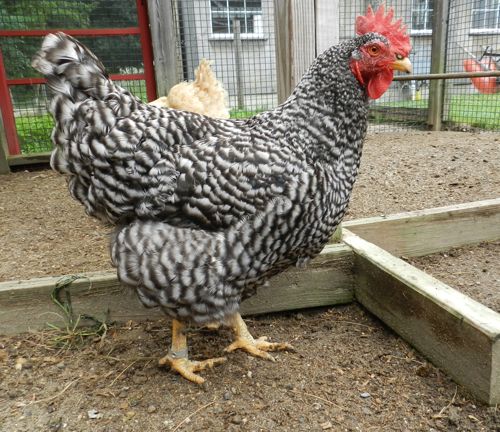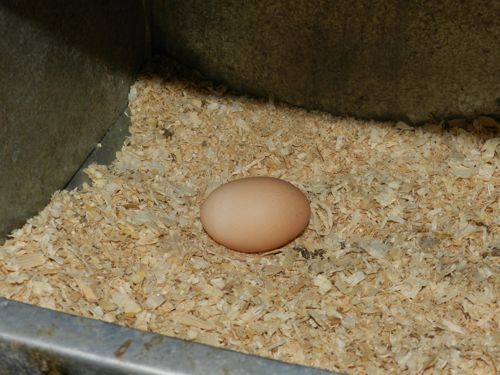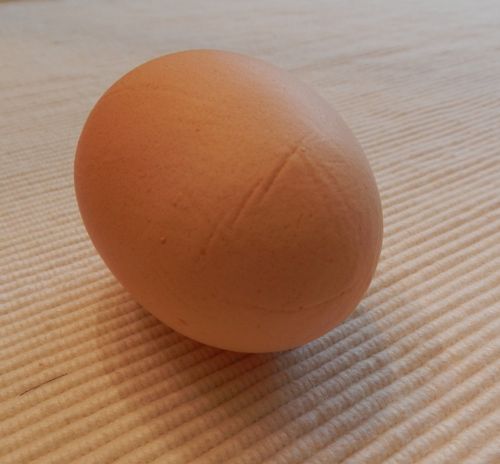None of the hens in the HenCam coop are in their prime. The youngest, the Golden Comets, Agnes and Philomena, are two years of age. The oldest, the Barred Rocks, are seven.
Here is Eleanor in her grand old age. She hasn’t laid an egg in ages.
But, the Comets have. They are designed for egg production. Their first year, between the age of 20 weeks and 20 months, they cranked out about five, or even six, eggs a week. They did this every week, right through the winter. Things slowed down the second year, but they kept laying. They’re heading into their third laying season and I’m still getting about four eggs a week from each hen. Tina Turner and Siouxsie are the same age as the Comets, and although they’re ditzy Polish hens, kept for decorative reasons, these hens lay every other day.
Each egg requires calcium for shell formation. My hens are fed quality commercial laying hen pellets that contain this essential mineral. They also have oyster shell free-choice. But, the calcium doesn’t go directly from the digestive tract to the shell. First it needs to be deposited in the bones, and then reabsorbed into the body in order to be useful. As the hens age, their bodies can’t keep up with the loss of calcium through shell manufacture. Things go wrong.
Last month, right around the time my hens were fighting off a respiratory disease, the Comets started laying soft-shelled eggs that broke before they hit the shavings in the nesting boxes. Then, Tina hunched over and laid eggs that were streaked with blood. Maizie became lethargic and her abdomen looked red and swollen. Antibiotics can cause problems, but there was something else going on here.
I took a hard look at my farm management. One of the things that I love about keeping chickens is that they eat up all the stuff I might otherwise throw out – stale bread, leftover pasta, a frozen pizza that, when cooked, was inedible. I was giving my hens the equivalent of junk food. In their prime, these girls could have eaten every bit and remained healthy (just like teenagers – I have two sons who seem to thrive on a diet of ice cream. Believe me, they’ve tried it.) But, these older hens needed more calcium, and more of the other vitamins and minerals in their laying hen pellets – which they weren’t eating because I’d given them a banquet of empty calories. There’s no way a hen is going to eat that boring oyster shell grit when there’s spaghetti in front of her. Even without the pasta, the girls aren’t fond of the oyster shell. Chickens don’t always “eat what they need.” None of us do.
So, as much as I’ve hated to do it, for the last two weeks I’ve been throwing my leftovers into the trash (I don’t have another predator and vermin-proof compost area to put it in.)
The girls say that they are starving. They tell me that every time I go into their run.
They’re not. They’re eating a balanced ration of laying hen pellets. They’re getting out onto the grass and scratching around in the dirt several times a week. They get a small handful of scratch corn in the morning for a treat. (Small! A few pecks each. Corn makes hens fat, and fat causes laying issues.)
They’re now laying these:
The eggs aren’t quite perfect yet. Look closely and you’ll see wrinkles.
But, the shells are thick enough to need a nice whack to crack.
When faced with thin-shelled eggs, the common advice is to add calcium to the diet. That might work -for a young flock. But, if you’ve got older girls, or if you’ve been cleaning out your kitchen shelves, don’t use your hens as garbage cans. A correct diet really is a miracle cure. My hens are relieved that I’ve finally figured this out. It must be mighty uncomfortable to try to push out breaking, rubbery eggs. They’re now walking upright and with gleams in their eyes. In a few more weeks, I’ll add some of the healthier kitchen scraps back into their diet and I’ll figure out a new composting system. But, for now, I don’t mind taking out the trash, and I sure do like seeing my hens thrive and having eggs to put in my basket.




Great info ! Sounds like a good idea to discard the junk and feed the more nutritious scraps. Also, Terry, do you open the chick cam large door only occasionally ? I see it is closed today, but on the Hen Cam can see the gems in the green yard, so there must be another opening. Little Blue enjoys sitting in the barn. So cute !
Sounds like you need a pig to round out the farm (and eat your leftovers).
You need a pig for your table scraps!
Jinx, Karen! Your comment wasn’t there when I wrote yesterday so I was surprsed to see your pig comment today. Great minds….
Excellent information, Terry! And it makes me feel really good! I was doing the right thing without even knowing it! I am very careful not to give my hens too much junk too often! I give them stuff to peck at every day but try very hard to limit the everyday treats to vegetables and fruit. They occasionally get bread, pasta, and rice but never days in a row! I have been trying to lose weight and, without realizing it, put my hens on the same diet I’ve been on! They seems to be doing better than me but I will keep trying!!
They do love them table scraps. I open the back door with that red coffee can in my hand and they come running from all corners of the yard and just about knock me down to get at it.
Terry one thing I’ve noticed since the hens get to free range all day is the shells have become extra hard. One of my “customers” kids me and says she needs a axe now to break one. It’s is true, I’ve noticed it as well. This weekend the holes will be dug and posts set for the new run, hopefully the hens won’t sabatoge it when I come back to work on Monday. ;-)
I wonder if it’s all that extra protein from the bugs. BTW, how ill you keep your chickens from “helping” you dig those holes?
The helping will definately be a problem. I have several that I’m sure will be scratching in every mound I dirt I pull out with the post hole digger. The worst one will be my Sussex, she is clueless that a shovel or any implement used to dig holes could remove her head. My guess is that I will have to put several in cages while I work.
I think I mentioned this before but since the tornado my feed bill has dropped by probably 25-30 percent. They definately look for food (grass, bugs and seeds) during the day before eating their Layena in the early evening.
Did anyone see which hen was in the bottom right nesting box? I found a lovely pointy brown egg there and I don’t know which old girl left it. Maizie? Twinkydink? If you see Buffy in a box, don’t get excited. She sits for a half hour, then clucks as if she’s laid something, but it’s all imaginary.
It was Twinkdink
Didn’t see the culprit, but pointy eggs in my experience means a Dotte at work…
My lot have never had scraps (mainly because I eat them all) so I hope you didn’t tell them your girls got pizza when you were here! I get wrinkly eggs from some of the older ones – it can be a sign that the hen at some point has had infectious bronchitis or similar respiratory thing that has passed unnoticed or cleared up on its own. Gladys makes a normal shell but the membranes sometimes require a knife – what is she up to there? Only once did I break it by pushing my thumb in hard. Not doing that again.
I’m guilty of giving my hens unhealthy scraps, but I’m doing it less and less and less because I want them to be healthy. Their favorite treat of anything is red grapes. PLEASE don’t anyone tell me they shouldn’t have grapes because it’s such fun to have them come take the grapes from me. Blueberries are also a big treat, but it’s funny that they don’t like strawberries. Mine free range all day and pincher bugs are their favorite source of protein.
My girls love grapes, too, and ignore strawberries. I give them bowls of milk which they love. I avoid wheat and offer them a few sunflower seeds as a treat. I give them corn, but mostly buy huge bags of frozen whole kernal corn and thaw it..or buy older sweet cob corn from a local food store for discount. They ignore dried corn and it attracts too many other creatures. The girls search for bugs all day and then snack on their layer crumble just before they roost. By the way, the bowls of milk stopped one old hen from laying rubber eggs last year. I give them lettuce from their own row in the garden, and whatever other greens I can find…and lots of chopped onions!
Chopped onions? That surprises me, but I have never tried it. Mine don’t like lettuce or any greens except grass and a little grass hay from my donkeys. Everyone said, Give them watermelon, but mine don’t eat much melon either:-/ I guess they have their preferences, just like us. Mine eat their pellets first thing in the morning and then right before bedtime.
They adore chopped onions! Terry has warned me against the stringy things like scallions, which the hens might have trouble swallowing properly…I chop everything. This year I planted mangels for them…sugar beets, which I will hang in the coop along with cabbages and mixed greens. Before winter, I gather bags of fallen leaves and store them. On blustery days I scatter a bag of leaves for the girls. I think they might find a few hibernating bugs, but it relieves stress just to scratch and search. My girls like the green part of watermelon rind. Isn’t it interesting to see what they like!
WOW! i never give my girls onions cause i was told it could flavor the eggs a bit “off” – i’ll have to try it now though if it’s such a potential treat :) thanks!!!
Onions might flavor milk from goats and cows, but has never affected the eggs! And I think they give a potential natural anti-bacterial effect for the girls. They like them raw or cooked.
My Ladies (and Gents) get whatever’s in the “chickie bucket” (a pan that sits by the stove). There’s also a compost bucket (coffee grounds, tea bags, and onion skins). Maddy (the dog) gets first call on the meat scraps. But since we’re on a no flour, no sugar diet (I’ve lost about 80 lbs. and maintained for about 4-5 years so far) there’s nothing but fruit and vegetable scraps (maybe once a week a little fat) in the chickie bucket. Once in a while I am given some stale bread and the hens get a treat. The hens pick over all the weeds pulled from the garden–I’ll tell you they don’t care for creeping charlie which is a major weed here. I give my hens their scratch feed in the early evening; my grandfather (who raised 4 kids on the proceeds from about 200 hens) always wanted the hens to go to roost with full crops. He would go down the roosts every night and touch crops just to check–I do the same thing. Anyway, I guess the point is that a healthy diet is good for man or beast!
Wow, Betsey, 80 lbs. is terrific ! What prompted you to adopt a no flour/sugar diet ? Has it been difficult ? Great work — maybe I’ll try it !
The “go to bed with a full crop” is actually a very good idea! The chickens continue to lay the shell layer on to their eggs while sleeping. They’re absorbing calcium from their bones, and it’s good for them to have more in their digestive tract to keep the whole process moving along smoothly. Smart grandfather!
I wonder if chickens want to do this naturally? Mine really want the crumble/pellets right before they go in for the night. They aren’t very interested the rest of the day since they are out free ranging. Right before bedtime, they want to fill themselves up, then go into the coop and roost for the night.
i’ve never heard this before – fascinating!!! i will have to start checking :)
Terry, I sent someone your way today! I was at work and someone was mentioning her chickens (now pullets). She is a farmer to be, as her home sits on acres and acres, so the chickens are her first step. I had to mention Nigerian Dwarf Goats (talking about them like Pip and Caper were my own, I found)! Seems like a good personality edition to any farm, if Little Pond is any indicaiton. Anyway, her name is Kelly, and I thought she would find everything here so helpful and fun. Look out for her in the comments. I do hope she drops by.
Thanks, Sean!
I’ve been reading a lot lately of people having great success using grapefruit seed extract and colloidal silver to treat general sickness in chickens and deal with respiratory illnesses. Some claim to have brought chickens back from the brink of death with these two natural medicines. I’m always looking for natural alternatives and these both possess antibacterial, antiviral, and antifungal properties with out side effects like calcium loss. Have you had any experience with using either of them?
While I think that many products, like yogurt and epsom salts, can improve the health of my flock, I am skeptical of “natural medicines” that supposedly cure all. If faced with an infectious disease decimating my flock, I’d stick with modern drugs. If a hen is doing poorly, I might try a folk medicine. However, I’ve had many chickens that have pulled through after a hot soaking bath and some TLC. Anecdotal stories can be misleading – but there’s often a grain of truth, too.
I grow several beds of swiss chard just for my 18 hens—year-round, since I am blessed to be in SoCal—and bunches of that, along with weeds and a few other stray greens and the occasional over-ripe squash or melon, keeps them healthy and happy. (They have a large pen, but are not free-range, since the “range’ is my vegetable garden!) My kitchen scraps go in the compost pile or the worm bin. Terry, have you tried composting with worms? Easy peasy, in any old kind of container.
I had my first chard of the season last night for dinner. Way too precious to give to the hens! They’ll be getting plenty of bug-ravaged leaves, though, later in the summer.
Hi, so glad I stumbled onto this site!
I’m new to chickens and got two RI Red pullets at 20 weeks old in May while I waited for my 15 chicks. They’ve each been giving me an egg a day and recently one of them has been laying “wrinkled eggs” and thin shelled eggs, but not every day. I have been giving them table scraps and after they’ve layed their eggs in the morning, I allow them to free range. I also give them the dehydrated mealy worms as a treat a few times a day. I just switched from crumbles to pellets and they don’t seem to like them! Should I switch back to the crumbles, or stick it out with the pellets? I hate to waste money/food!
I’m so glad you wrote – it gives me a chance to vent about the trend to buy meal worms for chickens. Not only is it expensive, but it’s unnecessary, especially for free-ranging hens. Also, although the commercial meal worms are likely safe, realize that meal worms are the larval stage of the dark wing (darkling) beetle’s life – a beetle which spreads parasites and E. coli on farms. As far as your hens turning their beaks up at pellets – well, they might not be too hungry, what with the treats and the free-ranging. Some hens do prefer crumbles, but they can certainly eat the bag of pellets that you bought. So, enjoy your hens, but stop feeding them quite so many treats! :)
Thanks for the advice! Not sure the chicks are going to like this any more than the two Reds will, but C’est la Vie!
95 in NH today? Chicks are under the coop in the shade and the hens are under the shrub roses as usual! They’re helping me keep down the population of Japanese beetles! No wonder they’re not eating pellets, I’ve just created spoiled hens
Like your idea about ice cubes in the water? How about something like Gatorade too?